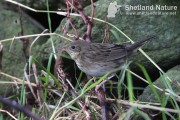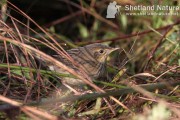Lanceolated Warbler
Posted by Martin Garner on Wednesday 6th October 2010 | Birding in Shetland
Wednesday 6th October proved to be one of the most remarkable of days. Breakfast had seen me counselling the member of our Shetland Nature Autumn Birding tour – “Don’t expect new birds today!” We had seen new birds every day. Today however, the SSW winds did not inspire ‘new bird confidence’. How wrong I was!
Thanks to James McCallum and Brydon, by early afternoon we had already enjoyed our second Sykes’s Warbler of the week giving point blank views as well as an array of scarce birds on Fetlar. We returned to Unst in late afternoon deciding to follow up a message from Robbie Brookes to Brydon describing a ‘funny little dark warbler’ that he couldn’t assign to genus. The bird being described to run along the ground, as opposed to hop urged Brydon to assume it most likely be a locustella. I wasn’t over optimistic but we thought we would have a look.
We arrived at Skaw at 4 pm to be greeted by rain.
Within 20 minutes I flushed a small warbler type from behind a shed at the farm, which zoomed around a corner and out of sight. I gathered the rest of the group to relocate it. Some 10 minutes later Paul Bright-Thomas and I had had first half decent, very brief views. A locustella warbler for sure; small, dark and heavily streaked above. Paul thought the pale tertial fringes looked crisp- I could not be sure. We gathered the group again, this time with news: It’s either a Grasshopper or Lanceolated Warbler (a species I had never before seen) – we think it might be the latter.
For about 40 -50 minutes we endeavoured to get more views. Not easy. Pouring rain and a secretive, mostly hidden bird. We pieced together:
- small and rather dark looking in flight ( we all had two day old experience of Grasshopper Warbler in flight)
- the tail looked tightly closed not so ‘floppy’ as in the ‘gropper’
- mantle looked like streaks were in solid lines (not broken dots)
- some streaking on lower flanks
- once seen to run along the fence line
Not enough. Suspicion high that might be Lanceolated Warbler, but not enough.
Eventually came the bird’s best showing. It hunkered out of the rain under a diesel tank. Now I could see the whole bird as I looked down on it facing away, with a full view of the back. A clear view, surely the identification would be blindingly obvious. I went straight for the easily seen tertials. Dumb struck I couldn’t believe it. They were so rain-soaked, as was most of the plumage that I couldn’t ‘read’ the key plumage patterns. The side of the undertail coverts were visible – but just looked ‘wet’. I could see a few obvious streaks on the flanks, but Grasshopper Warbler can show those too. Stuck! I just stared at this bird and felt stuck.
“Snap out of it Martin!” I counselled myself and started to try and note what I could see- the primary projection looked short – really short. It seems to be no much more than 1/3 of the tertials – was this useful? Then it turned and for the second time revealed a line of breast streaking, that extending to the breast sides, as also seen by our group member, Graham Croney. I tried to take a couple of photos in seeming near darkness (at ¼ of a second).
We then gathered and pieced together what we had and began to say “It has to be a Lancy”; the extent of the breast streaking, the upperparts streaking, and its small dark size and flight and that run-along-the fence-line thing. We allowed ourselves a moment of celebration- but were not done with our identification process yet.
As the sun began to set a massive double rainbow appeared over Skaw. Photos taken of ‘Team Lancy’. We then headed back to our accommodation at Saxa Vord for hot showers and dry clothes. I rang a couple of friends to process the bird’s identification with them. We then gathered around the dinner table to calmly process what we had seen, review the poor photos and some literature. One feature that really encouraged me personally was the primary projection. I had not hitherto appreciated its significance in identification. When the wing is tightly folded on Lanceolated it really can be as short as c30% of the tertial length versus c70% on Grasshopper Warbler.
I Spoke to Brydon on the phone. Told him about the Lancy, and he had good news too. He and James had seen the acroceplalus warbler we had agonised over 4 days earlier – now perched out, full views, photos and video, a Blyth’s Reed Warbler! Team delighted.
What a day – one of those you dream of. One great team working really well together. Brydon and James. Paul, Graham, Andrew and Chris. Oh – and me! Birding at its best.
The next morning with sun shining, twitchers arrived from all over Shetland to see the Lanceolated and the bird performed. It was dried out, looking pristine, all plumage feature visible; a straightforward identification. If only they knew!
Martin Garner



